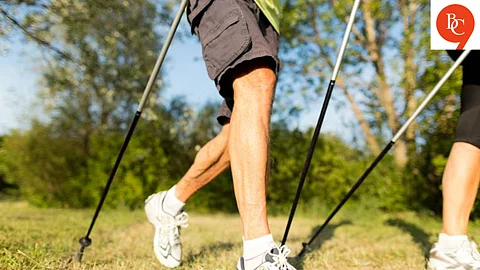

What Exactly Is Nordic Walking?
At its core, Nordic walking is a brisk walk enhanced by specially designed walking poles. Think of it as a cross between regular walking and cross-country skiing—except you can do it on roads, trails, or even in parks.
Developed in Finland in the 1930s as a summer training activity for skiers, Nordic walking activates 90% of the body’s muscles by engaging the upper body along with the legs. Unlike regular walking, your arms, shoulders, and back are all involved, thanks to the constant motion and pressure on the poles.
What Does Harvard Say About It?
According to a Harvard Health study, Nordic walking burns more calories than regular walking, improves cardiovascular fitness, and supports weight loss more effectively. The study found that participants who practiced Nordic walking three times a week had greater reductions in waist circumference and body fat percentage than those who walked without poles.
It also noted significant improvements in posture, mobility, and upper-body strength—making it especially beneficial for older adults or those recovering from injury.
Key Benefits of Nordic Walking
1. Burns More Calories Than Regular Walking
The addition of poles increases energy expenditure by up to 46% compared to regular walking.
2. Strengthens the Core and Upper Body
Using poles helps tone the arms, shoulders, chest, and abs, unlike standard walking which is primarily lower-body focused.
3. Improves Posture and Balance
The upright posture and rhythmic arm movement improve spinal alignment and help with balance—great for people who sit all day or have posture issues.
4. Gentle on Joints
Because it distributes weight across the whole body, Nordic walking is low-impact, making it ideal for people with knee or joint pain.
5. Mental Health Boost
Outdoor walking combined with mindful rhythm and movement can reduce stress, improve mood, and even help with mild depression or anxiety.
How to Get Started with Nordic Walking
You’ll need:
Nordic walking poles (not trekking poles—they're designed differently)
Comfortable walking shoes
Light breathable clothing
Basic Technique:
Walk naturally, with arms swinging freely.
Grip the pole handles lightly and plant them diagonally behind you.
Push off the poles as you step forward to engage your upper body.
Keep a straight posture and steady rhythm.
It may feel a bit awkward at first, but once you find your rhythm, it becomes fluid and energising.
Who Is It For?
Beginners looking for a low-risk way to start exercising
Fitness enthusiasts who want to add variety to their cardio
Older adults or post-injury individuals who need joint-friendly movement
Anyone trying to lose weight or tone up in a low-impact, sustainable way
How Often Should You Do It?
Start with 30 minutes, 3 times a week, and gradually increase the duration as your stamina builds. You can do it solo, with a group, or even on a scenic holiday trail—Nordic walking works just as well in your neighbourhood park as it does in the Alps.
Nordic walking is proof that fitness doesn’t have to be high-intensity to be effective. It’s simple, meditative, and accessible—yet offers impressive results when done consistently.
With benefits ranging from weight loss and strength building to improved posture and mental clarity, it’s no surprise that Harvard and fitness experts worldwide are giving this underrated form of exercise the spotlight it deserves.
